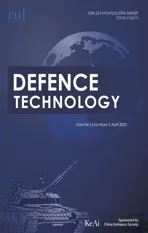Effect of microstructure on short pulse duration shock initiation of TATB and initial response mechanism
2020-05-23JunWangWeiCaoXiangliGuoBiChengLuluZhaoRuiruiLiuXiaoweiChen
Jun Wang , Wei Cao , Xiang-li Guo , Bi-o Cheng , Lu-lu Zhao , Rui-rui Liu ,Xiao-wei Chen *
a School of Mechatronical Engineering, Beijing Institute of Technology, Beijing,100081, China
b Institute of Chemical Materials, China Academy of Engineering Physics, No. 64, Mianshan Road, Mianyang City, China
Keywords:Short pulse duration shock initiation Microstructure TATB architecture Chemical reaction Initial response mechanism
ABSTRACT Micro-TATB particles with different sizes and 3D nanoporous TATB architectures with different specific surface areas were prepared through recrystallization to study short pulse duration shock initiation properties by electric gun technology. For micro-TATB, the initiation threshold significantly decreases with TATB average size ranging from 79.7 μm to 0.5 μm. For 3D nanoporous TATB architecture, the initiation threshold decreases and then increases with specific surface areas increased from 9.6 m2/g to 36.2 m2/g. The lowest initiation thresholds are obtained for the micro-TATB with average sizes of 1.3 μm and 0.5 μm, and 3D nanoporous TATB architecture with specific surface area of 22.4 m2/g. The shock initiation thresholds of micro-TATB and 3D nanoporous TATB architectures show significantly decreases with the porosity increased. The decomposition reaction and thermal conductivity properties were further investigated to understand the initial response mechanism.High porosity provides more collapse sites to generate high temperature for formation of hot spots. The low thermal conductivity and decomposition temperature could enhance the formation and ignition of the hot spots, and initial decomposition reaction of TATB. The effect of the decomposition temperature is higher than that of the thermal conductivity on the shock initiation properties. The enhanced decomposition reaction could promote energy release and transfer process from the ignition to the combustion.This work offers a new insight to understand the effects of microstructure on the shock initiation properties and the initial response mechanism of TATB.
1. Introduction
Explosives have been extensively used in military and civilian because of their high energy density and detonation characteristics.Shock initiation properties and mechanism of explosives have attracted significant research interest due to the demand of further development and practical applications [1-3]. The microstructure of explosives shows significant effects on the mechanical sensitivity,chemical reaction and shock initiation[4-7].Previously,the results of the experiments and simulations have demonstrated that the particle sizes and pore characteristics of explosives have great influences on the short pulse duration shock initiation properties.Decreasing particle size and increasing specific surface area of HNS(hexanitrostilbene) and LLM-105 (2,6-diamino-3,5-dinitropyrazine-1-oxide) could improve the shock initiation properties under flyer plate impact [8-11]. Various inert [12-13] and chemical reactive [14-16] simulations have been employed to understand the shock initiation mechanism of explosive with different particle sizes. However, the response mechanism of explosive with different microstructure is still not well studied and understood under short pulse duration shock.
The hot-spot theory and reaction rate model reported in previous literature [17-19] have been suggested that void collapse could lead to the temperature increasing and the formation of the hot spots, which induces decomposition and combustion reaction of explosive. Subsequently, enhanced and continuous combustion could result in build-up to detonation and shock-to-detonation transition (SDT). Therefore, the initial properties and response behavior of explosives with different microstructure are vital for the shock initiation process. Heat transfer, thermal decomposition behavior (activation energy and decomposition temperature) and combustion performance are crucial factors in the initial initiation stage, which determines the formation and growth process of the hot spots,ignition and combustion[20-21].Heat transfer(thermal conductivity),thermal decomposition reaction and combustion are affected by the micro-structure of the explosives, such as particle size,specific surface area and porosity[22-24].Especially for nanoexplosive, significantly improved thermal conductivity, decomposition reaction and combustion performance have been observed in previous experiments [25-26], which could affect the initiation performance. However, the initial response mechanism of nanoexplosive is still not well understood, which happens to be the scientific foundation of design and control of initiation properties.
TATB (1,3,5-triamino-2,4,6-trinitrobenzene) is commonly known as an insensitive energetic explosive, which has received significant interest owing to high safety. Some literature [27-29]reported the effects of three particle sizes and density on short pulse duration shock initiation properties.The short pulse duration shock initiation properties of TATB have been studied at high and low temperature [5-6]. Recently, we studied the effects of the thickness of the flyer on shock initiation properties of nano-TATB[30].However, the effects of the particle sizes ranging from micro-to nanometer, specific surface areas and microstructure of TATB on shock initiation properties are rarely reported. In this work,micro-TATB particles with different sizes and 3D nanoporous TATB architectures with different specific surface areas were prepared by recrystallization to study the influence of the microstructure on the shock initiation properties. An electric gun technology was used to produce the high-velocity flyer plate and short pulse duration for shock initiation TATB.The initial response mechanism was further illustrated by the thermal conductivity and decomposition reaction behavior of TATB with different microstructure.
2. Experimental
2.1. Preparation process of TATB with different microstructure
TATB (1,3,5-Triamino-2,4,6-trinitrobenzene) explosive with a purity of 99% were synthesized through the amination of TCTNB(1,3,5-trichloro-2,4,6-trinitrobenzene) in the toluene (Institute of Chemical Materials, CAEP. China). The concentrated sulfuric acid(97%H2SO4)was purchased from Shanghai experiment reagent Co.Ltd.China.As a typical experimental process,5.0 g TATB was added in 50 mL of concentrated sulfuric acid with magnetic stirring for 20 min for TATB dissolution at room temperature. The solution transferred into 500 mL of water to recrystallize and form micro-TATB particles. The product was filtered and cleaned by deionized water for several times, and then dried in a vacuum oven at 60°C for 20 h. The particle sizes of micro-TATB were controlled by temperature of water and the concentration of TATB. 3D nanoporous TATB architecture was prepared by self-assembly of nanoparticles.The detailed experimental process was reported in our recent work[31]. The TATB powder were pressed in a mould with a desired geometry under 2-10 MPa to obtain different density, and the resulted pellets were subjected to various initiation tests. The diameter and height of TATB pellets were 10 and 5 mm,respectively.
2.2. Characterization
The morphology of TATB was analyzed by field-emission scanning electron microscopy (FE-SEM). The specific surface area was tested by nitrogen desorption isotherm and calculated based on the multipoint Brunauer-Emmett-Teller (BET) model of nitrogen desorption isotherm.0.2 g TATB was added in water and stirred for 2 min to test the particle size and distribution of TATB by a Laser Particle Sizeron Coulter LS230 measurement at room temperature.
2.3. Shock initiation experiment
An electric gun (Fig. 1) was used as a classical technology to generate short-duration shock waves to study the effect of microstructure of TATB on the shock initiation properties. A detailed description of the electric gun experimental approach can be found in our work [30], therefore, a brief description of its operation is given here. The capacitance is 32 mF, resistance and Inductance were 20 mW and 32 nH. The maximum voltage is 40 kV. The thickest and diameter of aluminum flyer were 0.2 mm and 10 mm,respectively.Photonic Doppler Velocimetry(PDV)system was used to measure the particle velocity history of the transmitted wave at the interface between the rear surface of the explosive and a fused silica window.The average velocity of the aluminum flyer under the different initiation voltage is shown in Fig. 2. Many experiments were performed in order to ensure good statistics for the initiation threshold data. The experimental points represent the explosive's detonation at 50% probability.
2.4. Thermal conductivity and decomposition property
Differential scanning calorimetry (DSC) analyses were performed on a Mettler Toledo system under an N2flow(30 mL/min)over a temperature range from 50°C to 500°C at different heating rates (5°C/min, 10°C/min and 15°C/min). The sample mass was approximately 1.8-2.0 mg. Air may have been absorbed by the sample,which was removed by N2flow 10 min prior to increasing the temperature. Thermal conductivity of the samples was measured using LFA 457 Micro Flash instrument.The TATB powders were pressed to pellet with 2 mm thickness and 12.5 mm diameter.The measurements were performed with bulk specimens by putting the sensor between two similar slabs of material. The sensor supplies a heat pulse to the sample,and the thermal conductivity of the individual samples was obtained.
3. Results
3.1. The effect of particle size of micro-TATB on shock initiation properties
According to the hot-spot theory and previous literature[5-6],the particle sizes have obvious effect on the shock initiation property.In order to study the effect of TATB particle size on short pulse duration shock initiation properties, micro-TATB with different particle sizes were prepared by recrystallization.The particle size of micro-TATB was examined by laser diffraction particle size analyzer and shown in Table 1. The morphology of micro-TATB is shown in Fig.1.The average particle sizes of micro-TATB are 79.7 μm,16.9 μm,1.3 μm and 0.5 μm, respectively.

Table 1 Threshold voltage, pressure and P2 of TATB particles with different sizes.
Micro-TATB with different particle sizes was used to prepare pellets with density of 1.74 g/cm3for testing short pulse duration shock initiation properties.The threshold voltage at 50%probability and corresponding pressure and energy are shown in Table 1,which suggests a great influence of the particle sizes on the short duration pulse initiation properties.Interestingly,the experimental result of micro-TATB with average size of 1.3 μm is significantly lower than that of the other samples. This result is consistent with previous literature’ results [32-34], which indicates that micro-TATB(~1.3 μm and 0.5 μm) is more sensitive than coarse TATB under flyer plate impact. For TATB particle with average size of 0.5 μm,initiation threshold is low as same as that of ~1.3 μm,which may be caused by particle agglomeration. The similar results were observed in previous literature [27-28]. HNS explosive with average particle size of 1 μm showed lower shock initiation threshold[6-8].The pressure and P2twere calculated based on the average velocity of the flyer. The calculated process and method was described in Support Information. The shock durations for these experiments were calculated to be no more than 40 ns. The initiation energy(P2)further shows that reduced particle size could improve initiation properties.
3.2. The initiation properties of 3D nanoporous TATB architecture
Nano-size explosive could improve shock initiation properties owing high specific surface area and nanometer size effect[32-35].In this work, 3D nanoporous TATB architectures were prepared by self-assembly of nanoparticles.Based on FE-SEM,the whole size of 3D nanoporous TATB architectures is about 1-2 mm (Fig. 2(a)),which shows porous structure and morphology (Fig. 2). The size distributions of 3D TATB architectures are shown in Table 2. TATB nanoparticles ranging from 60 to 80 nm are connected with each other to form porous architecture (Fig. 2(b)-(f)). The specific surface areas of 3D nanoporous TATB architectures can be controlled ranging from 9.6 m2/g to 36.2 m2/g.
TATB pellets (1.74 g/cm3) of 3D nanoporous TATB architectures with different specific surface areas were prepared by compression molding. The short pulse duration shock properties of 3D TATB architectures with different specific surface areas (SSA)are shown in Fig. 3. A significant influence of the specific surface areas on shock initiation properties is observed. The 3D nanoporous TATB architecture with SSA of 22.4 m2/g shows the lowest threshold voltage and pressure. A higher and lower specific surface areas of 3D nanoporous TATB architectures show increased threshold voltage and pressure.A similar influence of SSA on shock initiation properties was observed for HNS and TATB explosive [8-9]. However, the particles sizes of TATB are different from the previous literature [27-29].
The threshold pressure andP2tof 3D nanoporous TATB architectures are shown in Table 2, which also suggests that minimum initiation pressure and energy exists for 3D nanoporous TATB architectures with SSA of 22.4 m2/g. As SSA increased, the initiation pressure and energy decrease first and then increase. For HNS explosive, the decreased initiation threshold was obtained for specific surface areas ranging from 10 to 20 m2/g [6-8].
3.3. The influence of porosity on shock initiation properties
TATB grains were pressed into pellet containing some volume fractions as voids. Porosity plays an important role in the shock initiation process for the formation and ignition of the hot spots[36-39].Micro-TATB particles with average size of 16.9 μm and 3D TATB architectures with SSA of 22.4 m2/g were used to study the effects of the porosity on the shock initiation properties. TATB pellets with four porosities(0.20,0.15,0.10 and 0.05)were prepared by controlled the mass of TATB and pressure.The calculated process of the porosity is shown in Support Information.The effects of the porosities on the shock initiation properties under flyer plate impact are shown in Fig.4.The results show clearly that increasedporosity is beneficial to the shock initiation by flyer plate impact.The threshold voltage of TATB pellet with density of 1.74 g/cm3is near one time higher than that of 1.56 g/cm3. The main reason is that those voids provide sites for the hot-spot formation and initial decomposition reaction. Compared with micro-TATB, 3D TATB architectures show low initiation threshold at the same density or porosity. 3D TATB architectures consisted of nanoparticles could enhance ignition and chemical decomposition reaction. The hotspot formation, ignition, chemical decomposition and combustion reaction play key role in shock-to-detonation transition(SDT).This result is important and helpful to understanding mechanism of the shock initiation by flyer plate impact for practical applications of TATB.

Table 2 Threshold of pressure and P2t of 3D nanoporous TATB architectures with different specific surface area.
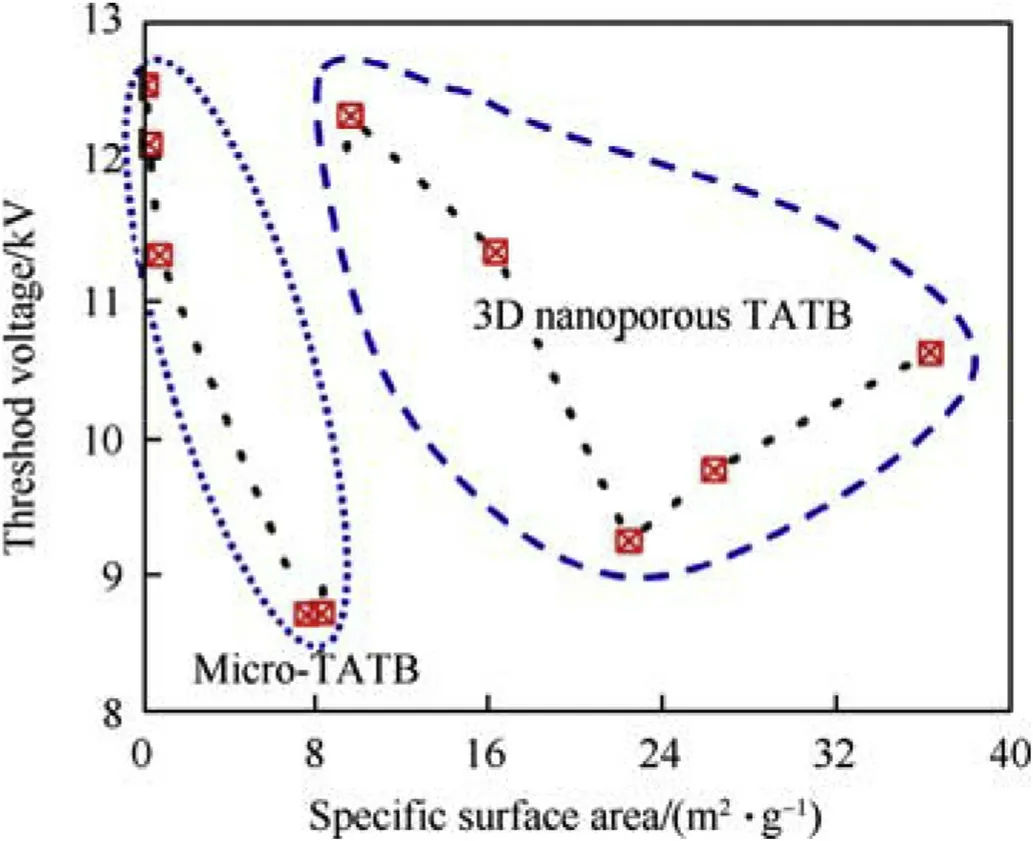
Fig. 3. The curves of threshold voltage and specific surface area of TATB. For micro-TATB, the lowest threshold voltage is obtained for TATB with SSA of 7.6 m2/g and corresponding average size of 1.3 μm and 0.5 μm 3D nanoporous TATB architectures with SSA of 22.4 m2/g shows lowest threshold voltage.
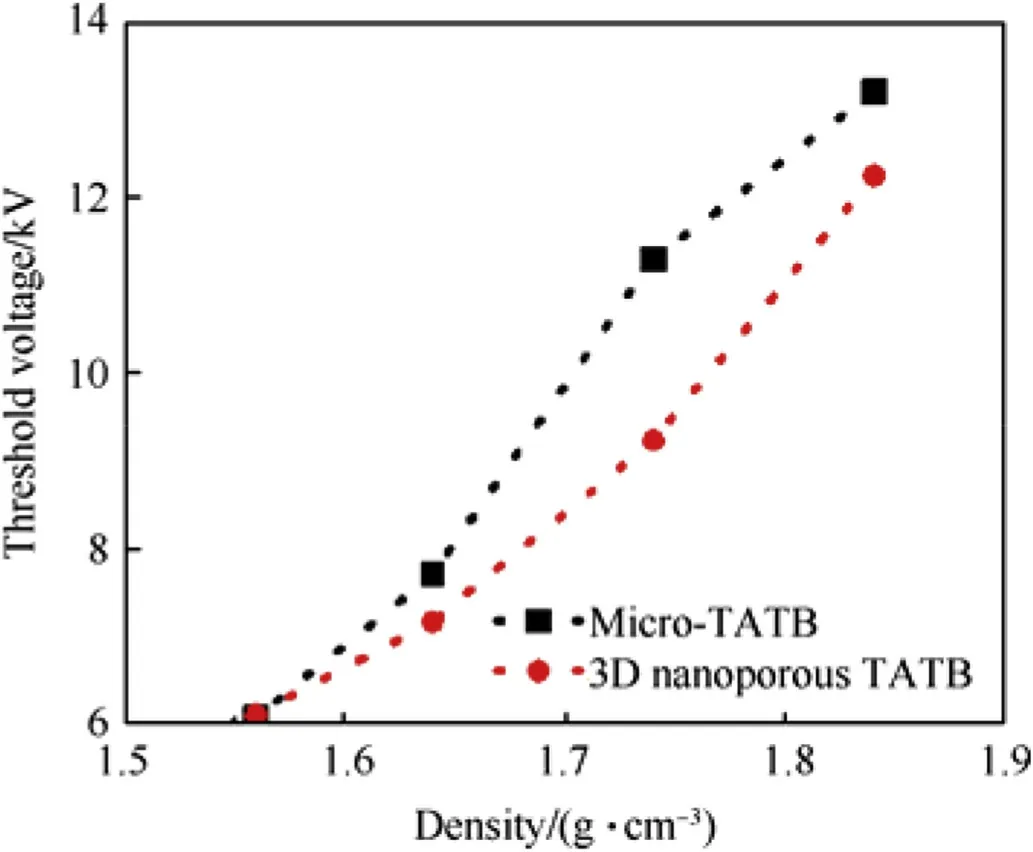
Fig. 4. Threshold voltages of TATB pellets with different densities. The corresponding porosities of TATB pellets are 0.2, 0.15, 0.10 and 0.05, respectively.
The initiation pressure and energy (P2t) of TATB pellet with different porosity are shown in Table 3, which suggests thatsignificantly decreased initiation pressure and energy exists for the high porosity of TATB pellet. Moreover, 3D nanoporous TATB architectures exhibit lower initiation pressure and energy than that of micro-TATB, resulting from the difference of microstructure.
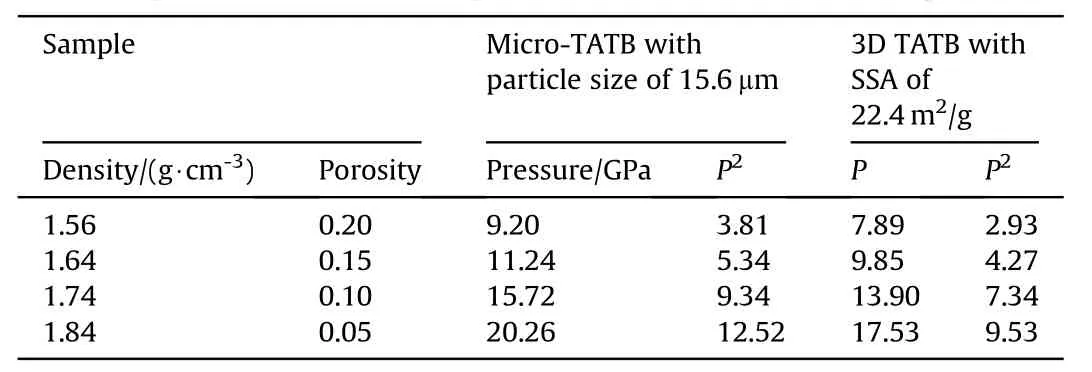
Table 3 Threshold pressure and P2t of TATB pellets with different densities and porosity.
3.4. The initial response mechanism of TATB with different microstructure
The initial response mechanism under shock loading by flyer plate impact is important to understand the effects of microstructure on the initiation properties.The SDT contains void collapse,the formation and ignition of the hot-spots, decomposition reaction,combustion and detonation. In this work, the initial stage mainly includes void collapse,the formation and ignition of the hot-spots,decomposition reaction and combustion process. According to the model of reaction rates in shocked multicomponent explosives reported by Kim [17], temperature was increased caused by the void collapse, thermal conductivity and chemical reaction. The relationship can be given by:
Where is temperature increasing resulting from plastic deformation of explosives under shock loading by flyer plate impact is temperature changing due to thermal conduction is temperature increasing resulting from chemical decomposition reaction of explosive, which contains slow reaction and fast reaction process.The decomposition reaction and slow combustion are contributed to slow reaction process. Temperature changing is a crucial factor for the formation and ignition of the hot spots,which is the key step for the shock initiation.In the initial stage,thermal conduction and decomposition reaction depend on the temperature changing.Therefore, it is crucial link to study thermal conductivity and decomposition reaction behavior to understand the initial response mechanism of the shock initiation process. The thermal conductivity, thermal decomposition reaction behavior of micro-TATB with different particle sizes and 3D nanoporous TATB architectures with different specific surface areas were studied to understand the initial response mechanism.
3.4.1. The thermal conductivity and thermal diffusivity of TATB
The thermal conductivity and thermal diffusivity, as essential thermodynamic parameters of explosives, can be used to estimate the sensitivity and safety. The thermal conductivity of explosive depends on the microstructure including particle size and morphology, porosity and distribution. In this work, thermal conductivity of micro-TATB with different sizes, 3D nanoporous TATB architectures with different specific surface areas and porosities were performed to illustrate the influence of microstructure on thermal conduction.
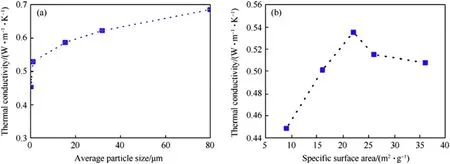
Fig. 5. Thermal conductivities of micro-TATB (a) and 3D nanoporous TATB architectures (b).
The thermal conductivities of micro-TATB with different particle sizes are shown in Fig.5(a).The experimental results show that the thermal conductivity is depended on the particle sizes of micro-TATB. Micro-TATB with average size of 0.5 μm has a lower thermal conductivity. Thermal diffusivities of micro-TATB also show a similar changed trend with the particle size(Table 3).Based on FESEM images (Fig.1), the TATB particles with small size are mostly isolated from each other, which is likely the reason for sizedependent thermal conductivity. Fig. 5(b) shows the influence of the specific surface areas of 3D TATB architectures on the thermal conductivity, which increases first and then decreases with the increased SSA. The highest thermal conductivity is 0.535 W/(m·K)for 3D TATB architecture with SSA of 22.4 m2/g.For specific surface area of 22.4 m2/g, nanoparticles tend to aggregate and form architecture with larger size of 2-3 mm, which have more interactions between nanoparticles. The interactions among nanoparticles could form a continuous path for heat transfer, and thus increase the overall thermal conductivity. However, for higher specific surface area of 36.2 m2/g, the nanoparticles are dispersed to prevent heat transfer among TATB nanoparticles.Thermal diffusivities of 3D TATB architectures with different specific surface areas are shown in Table 3. High thermal conductivity will enhance thermal conduction in combustion stage,which promotes the fast combustion reaction.
3.4.2. The thermal conductivity and thermal diffusivity of porosity
The inhomogeneous size and distribution of pores leads to a significant reduction in the thermal conductivity of porous materials. The thermal conductivities of TATB pellets with different porosities are shown in Table 4, which shows the thermal conductivity is depended on the porosity of TATB pellet. Clearly,introducing more pores in TATB pellets could reduce the thermal conductivity.Compared with micro-TATB,the thermal conductivity of 3D nanoporous TATB architectures show significantly decreased due to huge numbers of interfaces in 3D TATB architecture. The interfaces and the interfacial thermal conduction among the nanoparticles play a dominant role in the overall thermal transport.The results further confirmed that a higher interfacial thermal conduction among the connected particles would remarkably boost the thermal conductivity of 3D TATB architectures. Thermal diffusivity of micro-TATB and 3D TATB architectures are shown in Table 4.
3.4.3. Thermal decomposition reaction of TATB
Thermal decomposition reaction of TATB resulted from the ignition of the hot spots plays vital role in energy transfer and chemical reaction level in shock initiation process [40-41]. In this work, the thermal decomposition behavior of micro-TATB with different sizes and 3D nanoporous TATB architectures with different SSA were investigated by differential scanning calorimetry(DSC).
Fig. 6(a)-(b) shows DSC curves of micro-TATB with different sizes and 3D nanoporous TATB architectures with different SSA.For micro-TATB particles, it is found that the decomposition temperature is shifted to low temperatures with the particle size (specific surface area)decreased.For 3D nanoporous TATB architectures,the decomposition peak temperature first decreases and then increaseswith specific surface area increased.Fig.6(a)shows decomposition temperature peak of micro-TATB with different size and 3D nanoporous TATB architectures with different specific surface areas at three heating rates. The decomposition peak temperature are decreased and then increased with SSA increased.The trend of the decomposition peak temperature is uniform at different heating rates. The lowest decomposition temperature is observed for 3D nanoporous TATB architectures with SSA of 22.4 m2/g, which is beneficial to the ignition of hot spots and the initial chemical reaction.

Table 4 Thermal conductivities of TATB with different porosities.
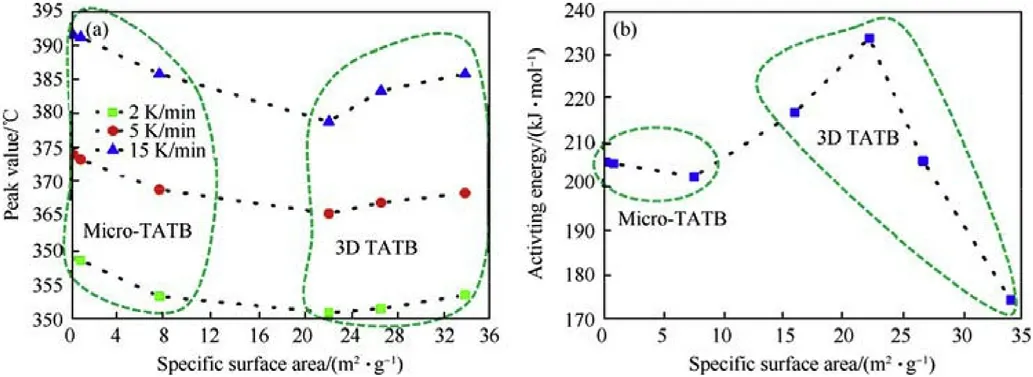
Fig. 6. (a) Decomposition temperature peaks of TATB with different heating rates(2 °C/min, 5 °C/min and 15 °C/min). (b) Activation energy of micro-TATB and 3D TATB architectures.
In order to calculate the pre-exponential factor (A) and the activation energy(Ea),the ASTM method E698[42-43]was used to determine the Arrhenius parameters. The equation and calculated process were given in Support Information.The calculated values of the activation energy of TATB are shown in Fig.6(b).For micro-TATB particles,activation energy decreases with the average particle size decreased. For 3D TATB architectures, the activation energy increases and then decreases with specific surface area increased.The highest activation energy is observed for 3D TATB architectures with specific surface area of 22.4 m2/g.
3.4.3. The initial response mechanism
The void collapse could lead to temperature increasing, which plays crucial role in the hot-spot formation process. High porosity of TATB offers more dimensional sites to collapse and generate high temperature [44-45]. The low decomposition temperature could improve ignition of the hot spots. However, high thermal conductivity could increase heat transfer to decrease temperature from the void collapse and decomposition reaction.Therefore,high porosity and low decomposition temperature of TATB shows improved shock initiation properties.
For micro-TATB, the low thermal conductivity could prevent heat transfer and improve the formation of the hot spots. The low decomposition temperature and activation energy effectively could enhance the ignition of the hot spots and decomposition reaction rate, which results in fast transfer from hot-spot ignition to combustion process. Therefore, decreased particle size could improve shock initiation properties. The lowest initiation thresholds are obtained for micro-TATB with particle sizes of 1.3 μm and 0.5 μm resulting from the lower decomposition temperature and thermal conductivity.The thermal conductivity of micro-TATB with particle size of 1.3 μm is higher than that of micro-TATB with particle sizes of 0.5 μm. However, micro-TATB with particle sizes of 1.3 μm and 0.5 μm have the same decomposition temperatures. The results show that the effect of the decomposition temperature is higher than that of the thermal conductivity on the shock initiation properties.
For 3D nanoporous TATB architectures,the thermal conductivity is increased and then decreased with specific surface area increased. The decomposition temperature is decreased and then increased with specific surface area increased. The low decomposition temperature could reduce the initial ignition temperature of hot spots and increase chemical reaction rate. The results also illustrate that the effect of the decomposition temperature is higher than that of the thermal conductivity on the shock initiation properties. Therefore, the significantly improved shock initiation property under short pulse duration is observed for 3D TATB architecture with SSA of 22.4 m2/g.
Based on the above results,the lower thermal conductivity and decomposition temperature may enhance the formation and ignition of the hot-spots.The effect of the decomposition temperature is higher than that of the thermal conductivity on the shock initiation properties. The lower decomposition temperature could enhance chemical reaction and energy release resulting in fast transfer process from hot-spot ignition to combustion reaction.The enhanced combustion reaction could promote the process of deflagration-to-detonation and improved shock initiation properties. However, the response mechanism of TATB with different microstructure is an extremely complex problem concerning thermodynamics, fluid mechanics, physics and chemistry in the process of the short pulse duration shock initiation, more experimental and theoretical works are necessary in further research.
5. Conclusions
Micro-TATB particles with different average sizes and 3D nanoporous TATB architectures with different specific surface areas were prepared by recrystallization to study short pulse duration shock initiation properties using the electric gun technology. For micro-TATB,the initiation thresholds are dependent on the particle size of TATB ranging from 79.7 μm to 0.5 μm. The lowest initiation threshold is observed for micro-TATB with average sizes of 1.3 μm and 0.5 μm. For 3D nanoporous TATB architectures, the initiation threshold increases and then decreases with SSA ranging from 9.6 to 36.2 m2/g. The lowest initiation threshold is observed for 3D nanoporous TATB architectures with SSA of 22.4 m2/g. Moreover,for micro-TATB and 3D nanoporous TATB architectures, the significantly decreased initiation threshold exists for high porosity.
High porosity offers more dimensional sites to collapse and generate high temperature to form hot spots. The low thermal conductivity could prevent heat transfer and enhance the formation of the hot spots. Furthermore, the low decomposition temperature could improve ignition of hot spots and initial decomposition reaction. The effect of the decomposition temperature is higher than that of the thermal conductivity on the shock initiation properties. This work provides approach to understand the relationship between structure and shock initiation properties and initial response mechanism of TATB.
Acknowledgements
This work is supported by National Natural Science Foundation of China (11702265,11872341 and 11602238).
Appendix A. Supplementary data
Supplementary data to this article can be found online at https://doi.org/10.1016/j.dt.2019.06.001.
杂志排行
Defence Technology的其它文章
- A comparison of the ballistic behaviour of conventionally sintered and additively manufactured alumina
- Effect of operating temperature on aged single lap bonded joints
- Investigation on energy output structure of explosives near-ground explosion
- Characteristics structure analysis on debris cloud in the hypervelocity impact of disk projectile on thin plate
- A fast-running method for blast load prediction shielding by a protective barrier
- Coating processes towards selective laser sintering of energetic material composites
